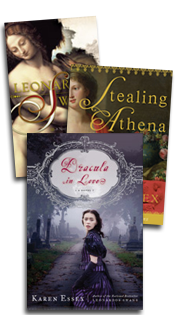On a trip to Milan, I visited The Last Supper, which can only be seen by appointment and in small groups. After everyone had left the room, I remained, strangely drawn to the mural on the opposite wall, the Crucifixion scene by Giovanni Montorfano. In the lower right corner, witnessing the Crucifixion, are several Dominican nuns. This caught my eye, having been educated by the Dominicans in New Orleans. Who, I wondered, was the ghostly figure kneeling in prayer, virtually nestled in the skirts of the nuns?
While the rest of the mural is in fine condition, the figure of the kneeling woman has all but disappeared. Being someone who unearths women’s hidden history, I had to find out more. Upon further investigation, I discovered that it was Beatrice d’Este, the young wife of Ludovico, the infamous duke of Milan and Leonardo’s patron. I also found out that it was Leonardo who had painted Beatrice into Montorfano’s mural. Why?
More curious still, I visited the Trivulzian library in the Castello Sforzesca, but found that it was closed for renovation. I pounded on the door, finally getting a reluctant librarian to open it. In my pathetic, broken Italian, I announced that I was a novelist looking for information on Beatrice. No one in the library spoke English, and besides, did I not understand that they were closed? With some persistence, I found a sweet-faced librarian who spoke French. Preying upon her kindness, I pleaded my case. With a bit of coaxing, she began to show me copies of exquisite miniatures of Beatrice and her children, as well as a bibliography that would be useful in finding out more about her fascinating, short life.
I found myself inexplicably moved by Beatrice’s tragic story. Later, while walking through the rooms of the Castello, I kept feeling an eerie, chilling aliveness. I believe that all writers and journalists feel this heightened awareness when a nascent story begins to blossom within us. I dug deeper, trying to find if there was a personal connection between Beatrice and Leonardo, when I discovered that during his years in Milan, Leonardo painted not only Beatrice, the duke’s 15-year- old wife, but Isabella, Beatrice’s illustrious sister, who was the Peggy Guggenheim of her time and who was having a flirtation with the duke; Cecilia Gallerani, the duke’s 17-year-old mistress; and Lucrezia Crivelli, the duke’s later mistress. Imagine, I thought, all these women competing for supremacy in the duke’s heart, while Leonardo was charged with painting them. The poor artist! Leonardo’s troubles with the duke are well known. Didn’t he have enough on his hands without having to negotiate around the duke’s love life?
I set out to find out everything I could about the Este sisters. I dug up books about their lives, mostly from the 19th century and long out of print. I read their letters, as well as letters by the courtiers of their time. I traversed northern Italy, visiting Ferrara, where they were born, and Mantua, where Isabella reigned as Marchesa. I visited the areas around Milan where Beatrice and Ludovico kept their “pleasure palaces.” I went to Venice, where both sisters came, one after the other, competing for the favor of the Doge and the Venetian Senate. By the time I came home, the story of these formidable women and their rivalries had started to write itself.



